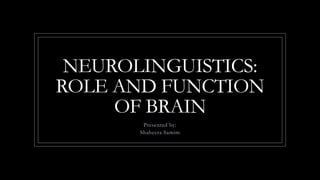
Neurolinguistics (final)
- 1. NEUROLINGUISTICS: ROLE AND FUNCTION OF BRAIN Presented by: Shaheera Samim
- 2. What is Neurolinguistics? It is defined as the relationship between language and communication, to different aspects of brain function, i.e., how our brain understands and produce langauge.
- 3. Understanding Brain In Terms Of Language
- 5. Brain and Second Language Learning (SLA)
- 6. Major Concerns of Neurologists Is the location and representation of L2 independent of L1’s location/position? Where are L2’s components stored in brain? How learner differences influence L2 learning?
- 7. Three 3 Foci of Neurolinguistics (for SLA) 1. Language and The Brain Lesson 2. Learning Processes Lesson 3. Learner Differences
- 8. 1. Language and The Brain (Location and Representation of Language in Brain) • Different researches have contrastive ideas about the location and representation of language in brain. • As per the researchers, L2 is not entirely present in L1’s location/positon. It can have a location of it’s own. • Ervin and Osgood language and brain can relate in three different ways coordinate, compound, and subordinate bilingualism.
- 9. Ervin and Osgood’s study Three ways Coordinate Parallel/Independent Linguistic System Compound Unified system Subordinate Bilingualism One Linguistic system accessed through other
- 10. 2. Learning Processes vs Purposed by Edward Thorndike Purposed by George A. Miller (The performance of brain against different learning processes)
- 11. Major Differences ◦ Learning language is a skill and is equal to learning any other skill, i.e., painting, driving a car. ◦ The developers of IP believe that more practice can enhance language proficiency. (“practice makes a man perfect)” ◦ There’re three stages: (1) Input (perception), (2) central processing, and (3) output (production) ◦ As per this theory language's proficiency can be increased through “stimulus- response” theory. ◦ L2’s efficiency does not involve depends on knowledge or abstract language learning rules ◦ Language proficiency depends on the association between stimulus and response ◦ Any change is the stimulus, response and the relationship between them can affect L2’s proficiency Information processing (IP) Theory
- 12. 3. Learner Differences (How different individual brains (learners) learn L2?) • This theory works to find out why some learners learn L2 more effectively than others? • This foci is the part of humanistic framework and highlights that emotional involvement, gender, and age are the factors that influence language learning. • Emotional factors consist of: motivation, aptitude. etc.
- 13. Learner Differences Age Adult learner vs young learners Gender Female’s and male’s contrastive/similar behavior towards language learning Aptitude Phonetic coding ability, grammatical sensitivity, etc. Motivation Intrinsic and extrinsic motivation Personality Different types of learners, i.e., extroverts and introverts
- 14. Conclusion • L2’s proficiency highly depends on the functioning of brain, and it’s good health. • Moreover, the brain’s performance is highly effected by individual’s motivation, aptitude, etc. Apart from that, learning processes also control the functioning of brain. For instance, in case of IP, practice helps learns achieve proficiency, whereas, in connectionism one has to strengthen the association between stimulus and response. • Neurolinguistics is all about studying how brain helps in learning language. The researchers of this area are introducing new L2 learning techniques which further helps in enhancing L2 proficiency.